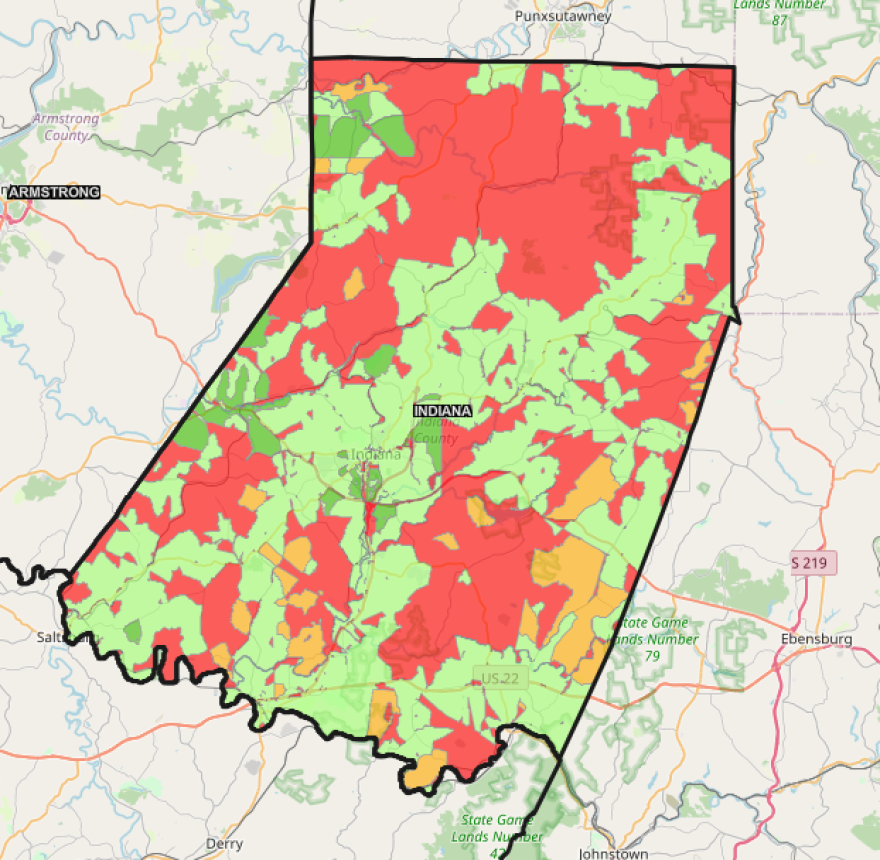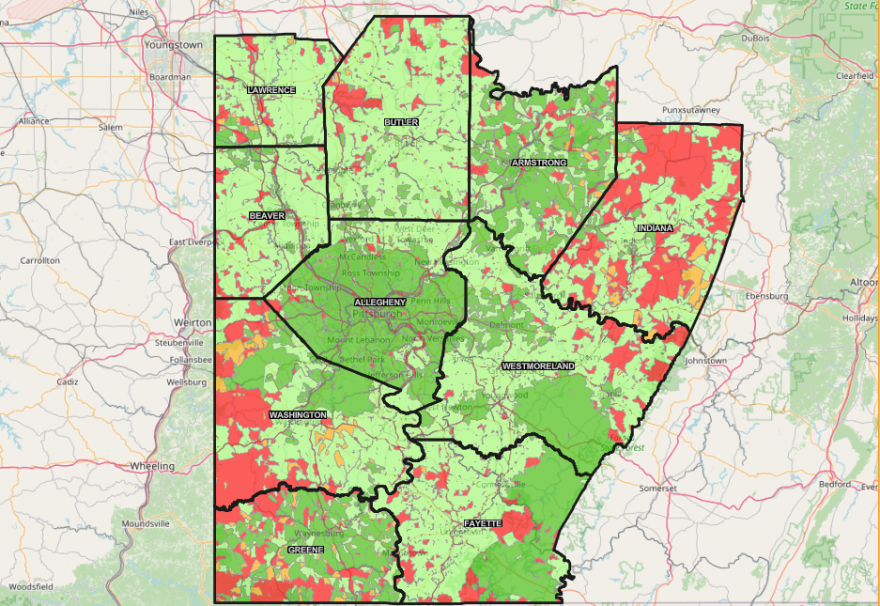A new map illustrates southwestern Pennsylvania’s dramatically uneven internet access. While Allegheny County is home to some of the region’s highest internet speeds, it also ranks next to Fayette and Indiana counties for the highest number of households with poor internet speeds. The data, compiled by the Southwestern Pennsylvania Commission and several regional nonprofits, was collected to help local leaders advocate for more federal help in expanding broadband access.
The report, by the Southwestern Pennsylvania Commission, Allies for Children and Carnegie Mellon University, looked at connectivity across the 10-county region, which also includes Armstrong, Beaver, Butler, Green, Lawrence, Washington and Westmoreland counties.
“Well served” areas are those with download and upload speeds greater than 100 megabits per second (Mbps). “Underserved” areas have speeds slower than 50 Mbps (download) and 10 Mbps (upload) per second. “Unserved” areas were defined as having speeds slower than 25 Mbps (download) and 3 Mbps (upload).
The federal government now defines high-speed broadband as 100 Mbps for downloading and 20 Mbps for uploading. Most of the region fell short of that.
Download speeds between 50 and 99 Mbps are common in Allegheny and Butler counties but are found only in small areas throughout the remaining eight counties.

Swaths of Fayette, Greene, Indiana and Washington counties have far slower speeds, less than 25 Mbps, and are considered “unserved” by the study. Lawrence County, Washington County and southern portions of Indiana county fell into the “underserved” category with download speeds of less than 50 Mbps. About 36,000 households, businesses, schools and libraries across the 10-county region were unserved or underserved.
In Indiana County, 7,600 households and businesses were defined as "unserved" by the study. In Fayette County, 7,100 were defined as "unserved."

Slower internet can be a big hurdle for students, employees and businesses, the study’s authors argue.
“A large portion of properties in the region capable of growth and development are impeded by poor or no access to broadband limiting the potential for economic growth,” the study argues.
The study included a survey of 3,445 residents about their broadband access.
The survey found that 12% of residents rely on their cellular data plan for their main home internet and 2% have no home internet access at all. The survey also uncovered variations based on age and race. 91% of Latino residents do not have a connected device other than their smartphone while 54% of respondents over the age of 65 use a desktop computer to access the internet.
The survey also asked about the cost and reliability of a respondent’s connection.
“Many of the personal stories we heard reinforced the mission of this initiative: that the internet is essential for our communities to connect and learn, it’s expensive and unreliable for many residents, and rural communities feel left behind,” said Jamie Baxter, executive director of Allies for Children.
In addition to poor service, the study found that many rural residents also are dissatisfied with how few internet providers are available to choose from. About 83% of survey respondents did not feel that they had a good selection of options. The report found that most households and businesses are served by two or three providers in the region. About 5% are served by only one provider.
Fewer providers mean less competition to drive down prices.
Households in urban areas also cited high costs as a hurdle. More than 87% of customers pay more than $75 per month for internet service, which is higher than the national average cost of $64 in 2021.
The survey responses provide new context that better illustrates how the broadband gap goes beyond a rural versus urban problem.
“We [also] looked at environmental justice factors…We analyzed where [the] population does not have access to a vehicle,” said Jeremy Jurick, National Broadband Services Director at Michael Baker International at a press conference Monday. “These typically overlooked populations were incorporated into this map.”
Information about access and the cost of an internet connection was difficult to uncover, according to Karen Lightman, director of Metro21: Smart Cities Institute at Carnegie Mellon University. “Part of the challenge that we had is historically both of these issues about access and affordability have been hidden and not transparent,” said Lightman
The study pointed to differences in existing broadband coverage data submitted to the Federal Communications Commission by internet service providers compared to what the study found. Authors argue the FCC data, “makes southwestern Pennsylvania appear to be very well served with highspeed internet available everywhere. This is a misleading representation.”
The data could now be used to help local leaders advocate for more federal aid from the infrastructure package and other programs. The infrastructure bill earmarked about $100 million per state initially for broadband expansion. Additional funds will be awarded based on which states have the highest number of unserved homes and businesses.
Andy Waple, Southwestern Pennsylvania Commission’s deputy executive director, said state leaders can cite the data in the study when pursuing those additional funds. “If we see an area on the FCC mapping that they’re saying is served but we know that is unserved, we can submit a challenge to that.”
The U.S. Department of Agriculture announced last year it would make $1.15 billion available to help people living in rural communities access high-speed internet.
The study suggests 13 county-specific improvement projects to boost connectivity and one “regional ring” project that would install fixed broadband along primary corridors and form more connection resiliency throughout the region.
“The Connectivity Roadmap provides us the tools we need to truly work together to prioritize projects to improve broadband and to reframe it as a public necessity,” said Lightman. “It also provides the information and resources our communities need to better understand what the internet can offer.”
View the map here:





